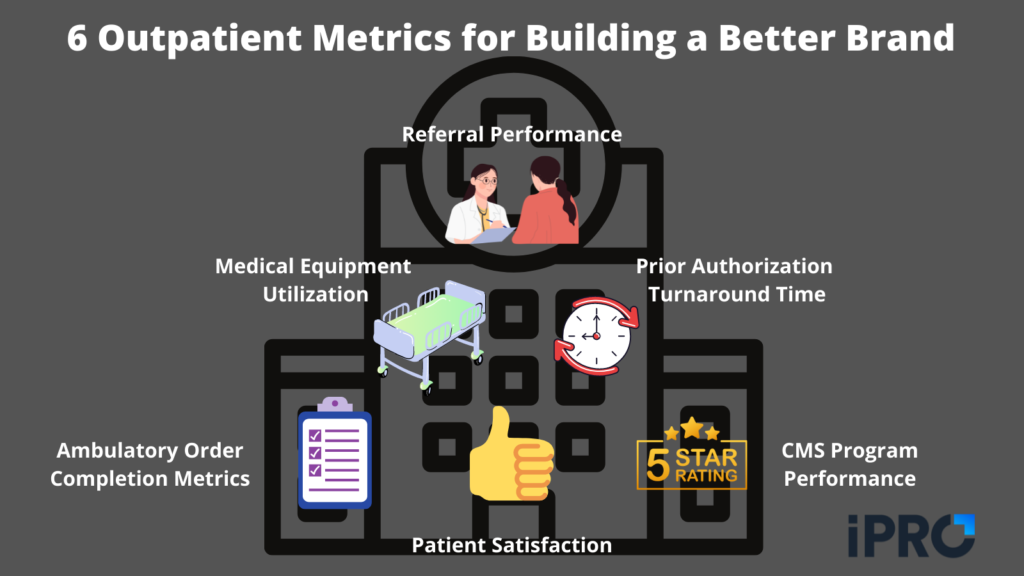As hospitals face a host of challenges, from COVID-19 to healthcare disruptors, building and maintaining an exceptional brand has never been more important. Referring providers and patients alike consider several traits when choosing a hospital for treatment, including:
- Reputation and Trust
- Efficiency
- Affordability
- Modern Technology and Equipment
- Patient and Provider Experience
In this blog, we’ll look at 6 outpatient metrics that hospitals should monitor – and improve – to create and maintain a favorable hospital brand. We’ll also look at how hospitals can use these metrics to position themselves to earn more business in the wake of increased competition.
Metrics to Build a Better Brand
To make it easier, we’ll break the metrics down into two categories: Operational and Patient-Centered.
Operational Outpatient Metrics
Operational outpatient metrics are like the framework or skeleton. These metrics provide the foundation for improving a hospital’s brand. Without them, patient-centered metrics (which we’ll discuss later) wouldn’t be possible.
Medical Equipment Utilization
Tracking metrics related to medical equipment utilization, such as diagnostic imaging, can help identify inefficiencies that could lead to longer wait times for patients or more work for staff. Similar to monitoring bed utilization which can help maximize bed capacity, leading to more patient throughput, hospitals can use these increased efficiencies to build a better brand by highlighting speed throughput in their marketing campaigns.
Referral Performance
Monitoring referral performance, such as the number of referrals coming in and cancellation rates, can help in a number of ways. First, it can help gauge your relationship with referring physicians. A low referral rate, and in particular a drop off in referrals, could indicate the need for strengthening that relationship. Second, high cancellation rates could be indicative of the need for better patient resources or outreach, such as:
- Automated appointment reminders
- Procedure-specific instructions/videos
- Navigation assistance such as GPS links or ride-share services
Referral management software is a great way to monitor referral performance. By monitoring and improving your referral performance, you can build a better relationship with both patients and referring providers. In addition to helping your hospital’s brand, gaining more referrals is one of our 6 ways to recover revenue and stop the leaks.
Prior Authorization Turnaround Time
Prior authorizations are a major pain point for providers, and they can also be a nuisance to patients. In fact, a 2021 AMA physician survey found that 93% of patients whose treatment requires prior authorization experience care delays at least sometimes. These care delays sometimes lead to abandoned care about 82% of the time. Furthermore, 34% of physicians said prior authorization delays have led to a serious adverse event (such as hospitalization, life-threatening event, or even death) for a patient in their care.
Monitoring prior authorization turnaround time can help prevent care delays and result in better health outcomes for patients and better financial outcomes for providers. Because following up on prior authorizations can be very time-consuming, consider outsourcing the prior authorization process to a third party. This can save your staff valuable time and increase turnaround time. Both of these benefits can strengthen your hospital’s brand and reputation with both patients and referring providers.
Ambulatory Order Completion Metrics
The final operational outpatient metrics hospitals can use to build their brand include a few ambulatory order completion metrics. The first metric is the percentage of ambulatory orders completed. A high completion (or “success”) rate is a great testament to a hospital’s efficiency and reliability. Patients and referring providers are certainly more likely to trust hospitals with high order success rates.
Another metric that is important to monitor is the length of time for ambulatory orders. Time is valuable to patients, which means both patients and providers will be impressed with short completion times. In short, an efficient ambulatory order process is crucial to building a better hospital brand.
Patient-Centered Outpatient Metrics
Patient-centered outpatient metrics are those that may be most helpful to a hospital’s brand in the minds of patients. While many of the operational outpatient metrics we covered can be leveraged to appeal to patients, the metrics in this section are even better for building trust with them.
Patient Satisfaction
Surprise, surprise: patient satisfaction metrics are one of the best ways to show your brand’s value to patients. Patient satisfaction can be gauged in a number of ways:
- HCAHPS scores
- Online reviews such as Google Reviews
- Patient satisfaction surveys
- Social listening – researching what people are saying about your hospital on social media
Hospitals can leverage high HCAHPS scores, Google reviews, and feedback from patients to encourage more patients and referring providers to choose them for their care.
CMS Hospital Outpatient Quality Reporting Program Peformance
The final metric hospitals can use to build a better brand is their Hospital Outpatient Quality Reporting Program score. This score is based on a variety of outpatient data reported to CMS. CMS publishes this data publicly “so people with Medicare and other consumers can find and compare the quality of care provided at ambulatory surgical centers.” Similar to HCAHPS scores and Google reviews, a high Hospital OQR score can be leveraged to increase patient volumes by assuring patients your hospital provides a great experience.
How iPro Can Help You Build a Better Brand

Now that we’ve covered the 6 outpatient metrics every hospital should monitor, improve, and leverage to build a better brand, let’s discuss how we at iPro can help. Our ambulatory order management solution, iOrder can revolutionize your outpatient processes by generating an electronic order with complete transparency and validation. This eliminates faxes and lost orders and allows the hospital and referring provider to track the order every step of the way.
iOrder can improve referral performance and ambulatory order success rates in a number of ways:
- A combination of order qualification questions (such as whether or not a patient’s weight exceeds equipment’s limit) and integrated clinical decision support (qCDSM) ensures the right order is submitted for the right patient and is in compliance with CMS guidelines, minimizing rescheduling/abandonment and maximizing reimbursement.
- Automated appointment reminders, links to procedure-specific instructions & videos, and GPS navigation assistance ensure patients are present and prepared at the time of the procedure, further reducing the possibility of rescheduling or abandonment.
- Live dashboards make it easy to track referrals, order completions and cancellations, efficiency, and more.
- An integration with Auth-Net removes the burden of prior authorizations from staff, saving time and ensuring prior authorizations are completed quickly and care isn’t delayed.
These features (and more) can not only improve your ambulatory department’s efficiency, but they can also lead to higher patient satisfaction. This can result in higher HCAHPS and Hospital OQR scores and more favorable online reviews and word of mouth. Increased efficiency and high patient satisfaction can both be leveraged in your hospital’s brand-building and outreach initiatives to attract more patients and referring providers.
If you’d like to see iOrder in action, schedule a free demo today.




